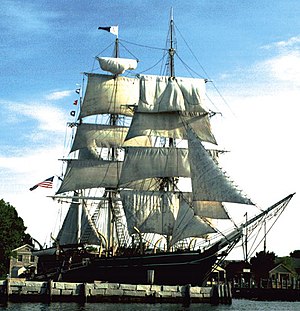Charles W. Morgan (ship)

Charles W. Morgan at Mystic Seaport, CT
|
|
| History | |
|---|---|
|
|
|
| Owner: |
|
| Builder: | Jethro and Zachariah Hillman, New Bedford, Massachusetts |
| Launched: | 1841 |
| Identification: |
|
| Status: | Museum ship |
| General characteristics | |
| Tonnage: | 351.3 (Old Tons); 313.8 (New Tons) |
| Length: | 113 ft (34 m) LOA |
| Beam: | 27 ft 6 in (8.38 m) |
| Depth: | 17 ft 6 in (5.33 m) |
| Sail plan: | Double-topsail bark rig; 13,000 sq ft (1,200 m2) of sail |
|
Charles W. Morgan
|
|
| Location | Mystic, Connecticut |
| Coordinates | 41°21′46.04″N 71°57′54.89″W / 41.3627889°N 71.9652472°WCoordinates: 41°21′46.04″N 71°57′54.89″W / 41.3627889°N 71.9652472°W |
| Built | 1841 |
| Architectural style | Other |
| Part of | Mystic Bridge Historic District (#79002671) |
| NRHP Reference # | 66000804 |
| Significant dates | |
| Added to NRHP | 13 November 1966 |
| Designated NHL | 13 November 1966 |
| Designated CP | August 31, 1979 |
Charles W. Morgan is an American whaling ship built in 1841 whose active service period was during the 19th and early 20th centuries. Ships of this type were usually used to harvest the blubber of whales for whale oil, which was commonly used in lamps. The ship has served as a museum ship since the 1940s, and is now an exhibit at the Mystic Seaport museum in Mystic, Connecticut. She is the world's oldest surviving merchant vessel, and the only surviving wooden whaling ship from the 19th century American merchant fleet. She was designated a National Historic Landmark in 1966.
Charles Waln Morgan chose Jethro and Zachariah Hillman's shipyard in New Bedford, Massachusetts to construct a new ship.Charles W. Morgan's live oak keel was laid down in February 1841 and fastened together with copper bolts. The bow and stern pieces of live oak were secured to the keel by an apron piece. The sturdy stern post was strengthened with hemlock root and white oak. Yellow pine shipped from North Carolina was used for the ship's beams and hemlock or hackmatack was used for the hanging knees.
Construction of Charles W. Morgan proceeded until April 19, 1841, when the workers went on strike, demanding a ten-hour work day. The strike gathered support until it encompassed the shipyard, the oil refineries, and the cooper shops; Morgan was appointed chairman of the employers and given the task of resolving the strike. Morgan opposed their demands, and a meeting with four master mechanics ended in failure. On May 6, an agreement was reached when the workers accepted a ten-and-a-half-hour workday. Work resumed on the ship without incident and she was launched on July 21, 1841. The ship was registered as a caravel of 106 1⁄2 feet (32.5 m) in length, 27 feet 2 1⁄2 inches (8.293 m) inches in breadth, and 13 feet 7 1⁄4 inches (4.147 m) in depth. Her displacement was 314 gross tons The ship's construction and rigging cost a total of $32,562.08 and was assessed a shipyard fee of $2.25 per day for its 258 days of construction; labor charges was billed at $1.75 a day for 129½ days.
...
Wikipedia


